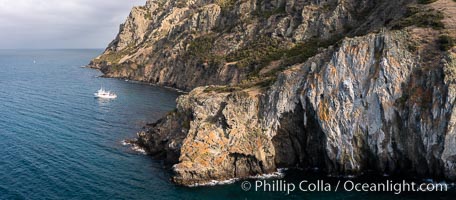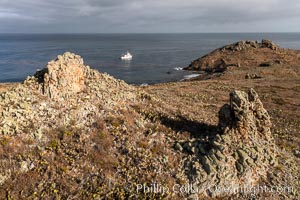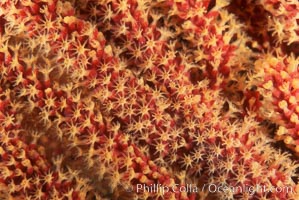
California Golden gorgonian polyps. The golden gorgonian is a colonial organism composed of thousands of tiny polyps. Each polyp secretes calcium which accumulates to form the structure of the colony. The fan-shaped gorgonian is oriented perpendicular to prevailing ocean currents to better enable to filter-feeding polyps to capture passing plankton and detritus passing by.
Species: California golden gorgonian, Muricea californica
Location: San Clemente Island, California
Image ID: 03481
Species: California golden gorgonian, Muricea californica
Location: San Clemente Island, California
Image ID: 03481
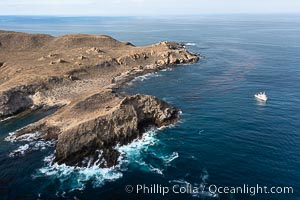
Boat Horizon at San Clemente Island, anchored near Balanced Rock and Pyramid Cove point.
Location: San Clemente Island, California
Image ID: 38199
Location: San Clemente Island, California
Image ID: 38199
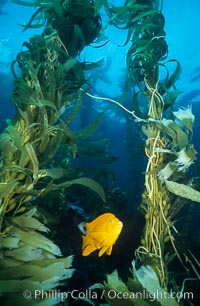
Garibaldi in kelp forest.
Species: Garibaldi, Hypsypops rubicundus, Macrocystis pyrifera
Location: San Clemente Island, California
Image ID: 01055
Species: Garibaldi, Hypsypops rubicundus, Macrocystis pyrifera
Location: San Clemente Island, California
Image ID: 01055
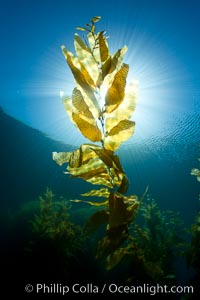
Giant kelp, blades, stipes and pneumatocysts, backlit by the sun in shallow water.
Species: Giant kelp, Macrocystis pyrifera
Location: San Clemente Island, California
Image ID: 25401
Species: Giant kelp, Macrocystis pyrifera
Location: San Clemente Island, California
Image ID: 25401
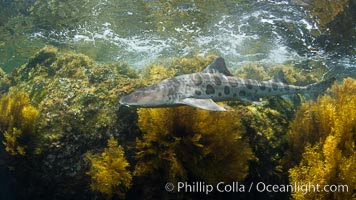
A leopard shark, swimming through the shallows waters of a California reef, underwater, Cystoseira osmundacea marine algae growing on rocky reef.
Species: Leopard shark, Cystoseira osmundacea, Triakis semifasciata
Location: San Clemente Island, California
Image ID: 25417
Species: Leopard shark, Cystoseira osmundacea, Triakis semifasciata
Location: San Clemente Island, California
Image ID: 25417
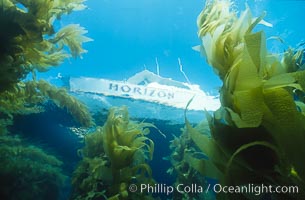
Boat Horizon above kelp forest.
Species: Giant kelp, Macrocystis pyrifera
Location: San Clemente Island, California
Image ID: 03764
Species: Giant kelp, Macrocystis pyrifera
Location: San Clemente Island, California
Image ID: 03764
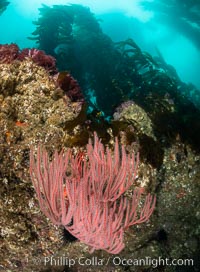
Red gorgonian on rocky reef, below kelp forest, underwater. The red gorgonian is a filter-feeding temperate colonial species that lives on the rocky bottom at depths between 50 to 200 feet deep. Gorgonians are oriented at right angles to prevailing water currents to capture plankton drifting by.
Species: Red gorgonian, Leptogorgia chilensis, Lophogorgia chilensis
Location: San Clemente Island, California
Image ID: 37055
Species: Red gorgonian, Leptogorgia chilensis, Lophogorgia chilensis
Location: San Clemente Island, California
Image ID: 37055
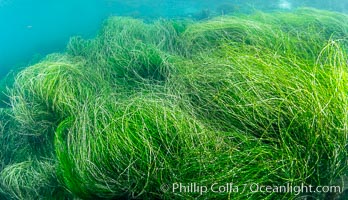
Surfgrass (Phyllospadix), moving with waves in shallow water, San Clemente Island.
Species: Surfgrass, Phyllospadix
Location: San Clemente Island, California
Image ID: 37064
Species: Surfgrass, Phyllospadix
Location: San Clemente Island, California
Image ID: 37064
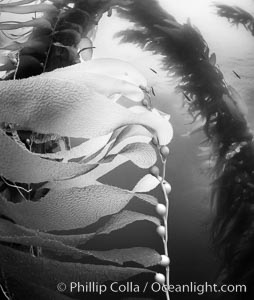
Kelp fronds and pneumatocysts. Pneumatocysts, gas-filled bladders, float the kelp plant off the ocean bottom toward the surface and sunlight, where the leaf-like blades and stipes of the kelp plant grow fastest. Giant kelp can grow up to 2' in a single day given optimal conditions. Epic submarine forests of kelp grow throughout California's Southern Channel Islands.
Species: Giant kelp, Macrocystis pyrifera
Location: San Clemente Island, California
Image ID: 37076
Species: Giant kelp, Macrocystis pyrifera
Location: San Clemente Island, California
Image ID: 37076
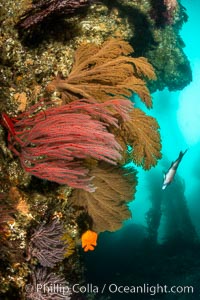
Red gorgonian and California golden gorgonian on underwater rocky reef below kelp forest, San Clemente Island. Gorgonians are filter-feeding temperate colonial species that lives on the rocky bottom at depths between 50 to 200 feet deep. Each individual polyp is a distinct animal, together they secrete calcium that forms the structure of the colony. Gorgonians are oriented at right angles to prevailing water currents to capture plankton drifting by, San Clemente Island. Gorgonians are oriented at right angles to prevailing water currents to capture plankton drifting by.
Species: Red gorgonian, Leptogorgia chilensis, Lophogorgia chilensis
Location: San Clemente Island, California
Image ID: 37115
Species: Red gorgonian, Leptogorgia chilensis, Lophogorgia chilensis
Location: San Clemente Island, California
Image ID: 37115
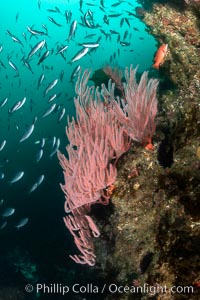
Red gorgonian on rocky reef, below kelp forest, underwater. The red gorgonian is a filter-feeding temperate colonial species that lives on the rocky bottom at depths between 50 to 200 feet deep. Gorgonians are oriented at right angles to prevailing water currents to capture plankton drifting by.
Species: Red gorgonian, Leptogorgia chilensis, Lophogorgia chilensis
Location: San Clemente Island, California
Image ID: 37120
Species: Red gorgonian, Leptogorgia chilensis, Lophogorgia chilensis
Location: San Clemente Island, California
Image ID: 37120
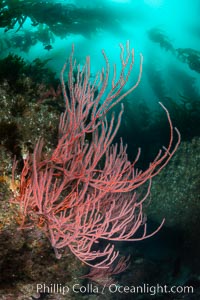
Red gorgonian on rocky reef, below kelp forest, underwater. The red gorgonian is a filter-feeding temperate colonial species that lives on the rocky bottom at depths between 50 to 200 feet deep. Gorgonians are oriented at right angles to prevailing water currents to capture plankton drifting by.
Species: Red gorgonian, Leptogorgia chilensis, Lophogorgia chilensis
Location: San Clemente Island, California
Image ID: 37124
Species: Red gorgonian, Leptogorgia chilensis, Lophogorgia chilensis
Location: San Clemente Island, California
Image ID: 37124
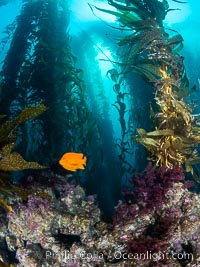
The Kelp Forest and Rocky Reef of San Clemente Island. Giant kelp grows rapidly, up to 2' per day, from the rocky reef on the ocean bottom to which it is anchored, toward the ocean surface where it spreads to form a thick canopy. Myriad species of fishes, mammals and invertebrates form a rich community in the kelp forest. Lush forests of kelp are found throughout California's Southern Channel Islands.
Species: Giant kelp, Garibaldi, Macrocystis pyrifera, Hypsypops rubicundus
Location: San Clemente Island, California
Image ID: 38513
Species: Giant kelp, Garibaldi, Macrocystis pyrifera, Hypsypops rubicundus
Location: San Clemente Island, California
Image ID: 38513
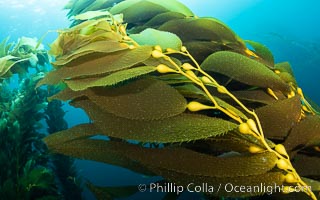
Kelp fronds showing pneumatocysts, bouyant gas-filled bubble-like structures which float the kelp plant off the ocean bottom toward the surface, where it will spread to form a roof-like canopy.
Species: Giant kelp, Macrocystis pyrifera
Location: San Clemente Island, California
Image ID: 38518
Species: Giant kelp, Macrocystis pyrifera
Location: San Clemente Island, California
Image ID: 38518
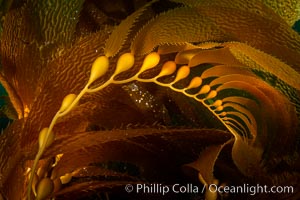
Kelp fronds and pneumatocysts. Pneumatocysts, gas-filled bladders, float the kelp plant off the ocean bottom toward the surface and sunlight, where the leaf-like blades and stipes of the kelp plant grow fastest. Giant kelp can grow up to 2' in a single day given optimal conditions. Epic submarine forests of kelp grow throughout California's Southern Channel Islands.
Species: Giant kelp, Macrocystis pyrifera
Location: San Clemente Island, California
Image ID: 34599
Species: Giant kelp, Macrocystis pyrifera
Location: San Clemente Island, California
Image ID: 34599
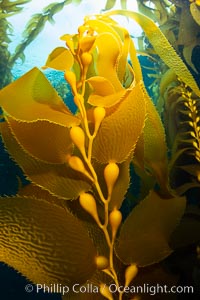
Kelp fronds and pneumatocysts. Pneumatocysts, gas-filled bladders, float the kelp plant off the ocean bottom toward the surface and sunlight, where the leaf-like blades and stipes of the kelp plant grow fastest. Giant kelp can grow up to 2' in a single day given optimal conditions. Epic submarine forests of kelp grow throughout California's Southern Channel Islands.
Species: Giant kelp, Macrocystis pyrifera
Location: San Clemente Island, California
Image ID: 34603
Species: Giant kelp, Macrocystis pyrifera
Location: San Clemente Island, California
Image ID: 34603
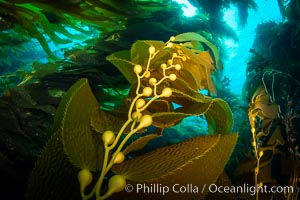
Kelp fronds and pneumatocysts. Pneumatocysts, gas-filled bladders, float the kelp plant off the ocean bottom toward the surface and sunlight, where the leaf-like blades and stipes of the kelp plant grow fastest. Giant kelp can grow up to 2' in a single day given optimal conditions. Epic submarine forests of kelp grow throughout California's Southern Channel Islands.
Species: Giant kelp, Macrocystis pyrifera
Location: San Clemente Island, California
Image ID: 34606
Species: Giant kelp, Macrocystis pyrifera
Location: San Clemente Island, California
Image ID: 34606
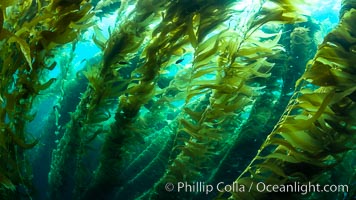
The Kelp Forest of San Clemente Island, California. A kelp forest. Giant kelp grows rapidly, up to 2' per day, from the rocky reef on the ocean bottom to which it is anchored, toward the ocean surface where it spreads to form a thick canopy. Myriad species of fishes, mammals and invertebrates form a rich community in the kelp forest. Lush forests of kelp are found throughout California's Southern Channel Islands.
Species: Giant kelp, Macrocystis pyrifera
Location: San Clemente Island, California
Image ID: 34609
Species: Giant kelp, Macrocystis pyrifera
Location: San Clemente Island, California
Image ID: 34609
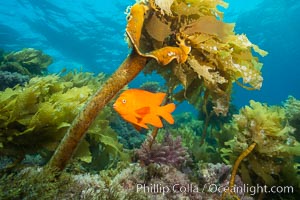
Garibaldi swimming through southern sea palm, San Clemente Island.
Species: Garibaldi, Southern sea palm, Eisenia arborea, Hypsypops rubicundus
Location: San Clemente Island, California
Image ID: 30877
Species: Garibaldi, Southern sea palm, Eisenia arborea, Hypsypops rubicundus
Location: San Clemente Island, California
Image ID: 30877
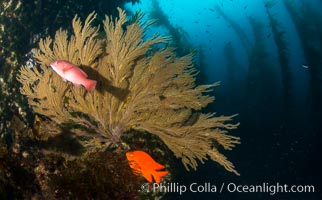
California golden gorgonian, Garibaldi and Sheephead wrasse fishes on rocky reef, below kelp forest, underwater. The golden gorgonian is a filter-feeding temperate colonial species that lives on the rocky bottom at depths between 50 to 200 feet deep. Each individual polyp is a distinct animal, together they secrete calcium that forms the structure of the colony. Gorgonians are oriented at right angles to prevailing water currents to capture plankton drifting by.
Species: California golden gorgonian, California sheephead wrasse, Garibaldi, Hypsypops rubicundus, Muricea californica, Semicossyphus pulcher
Location: San Clemente Island, California
Image ID: 30922
Species: California golden gorgonian, California sheephead wrasse, Garibaldi, Hypsypops rubicundus, Muricea californica, Semicossyphus pulcher
Location: San Clemente Island, California
Image ID: 30922
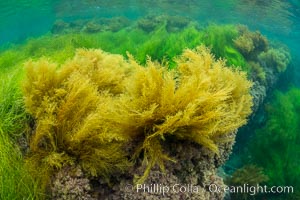
Stephanocystis dioica (yellow) and surfgrass (green), shallow water, San Clemente Island.
Species: Surfgrass, Phyllospadix, Stephanocystis dioica
Location: San Clemente Island, California
Image ID: 30946
Species: Surfgrass, Phyllospadix, Stephanocystis dioica
Location: San Clemente Island, California
Image ID: 30946
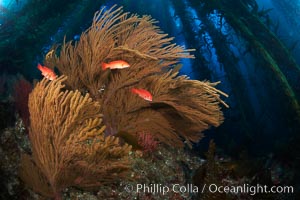
California golden gorgonian and small juvenile sheephead fishes on rocky reef, below kelp forest, underwater. The golden gorgonian is a filter-feeding temperate colonial species that lives on the rocky bottom at depths between 50 to 200 feet deep. Each individual polyp is a distinct animal, together they secrete calcium that forms the structure of the colony. Gorgonians are oriented at right angles to prevailing water currents to capture plankton drifting by.
Species: California golden gorgonian, Muricea californica, Semicossyphus pulcher
Location: San Clemente Island, California
Image ID: 23421
Species: California golden gorgonian, Muricea californica, Semicossyphus pulcher
Location: San Clemente Island, California
Image ID: 23421
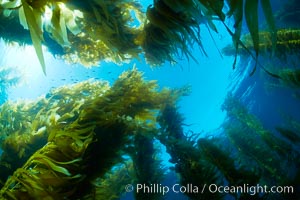
Giant kelp plants lean over in ocean currents, underwater. Individual kelp plants grow from the rocky reef, to which they are attached, up to the ocean surface and form a vibrant community in which fishes, mammals and invertebrates thrive.
Species: Giant kelp, Macrocystis pyrifera
Location: San Clemente Island, California
Image ID: 23426
Species: Giant kelp, Macrocystis pyrifera
Location: San Clemente Island, California
Image ID: 23426
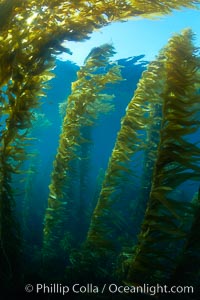
A kelp forest. Giant kelp grows rapidly, up to 2' per day, from the rocky reef on the ocean bottom to which it is anchored, toward the ocean surface where it spreads to form a thick canopy. Myriad species of fishes, mammals and invertebrates form a rich community in the kelp forest. Lush forests of kelp are found through California's Southern Channel Islands.
Species: Giant kelp, Macrocystis pyrifera
Location: San Clemente Island, California
Image ID: 23428
Species: Giant kelp, Macrocystis pyrifera
Location: San Clemente Island, California
Image ID: 23428
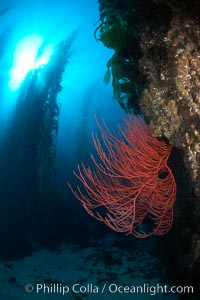
Red gorgonian on rocky reef, below kelp forest, underwater. The red gorgonian is a filter-feeding temperate colonial species that lives on the rocky bottom at depths between 50 to 200 feet deep. Gorgonians are oriented at right angles to prevailing water currents to capture plankton drifting by.
Species: Red gorgonian, Leptogorgia chilensis, Lophogorgia chilensis, Macrocystis pyrifera
Location: San Clemente Island, California
Image ID: 23431
Species: Red gorgonian, Leptogorgia chilensis, Lophogorgia chilensis, Macrocystis pyrifera
Location: San Clemente Island, California
Image ID: 23431
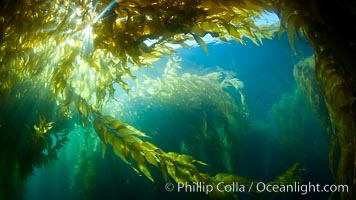
A view of an underwater forest of giant kelp. Giant kelp grows rapidly, up to 2' per day, from the rocky reef on the ocean bottom to which it is anchored, toward the ocean surface where it spreads to form a thick canopy. Myriad species of fishes, mammals and invertebrates form a rich community in the kelp forest. Lush forests of kelp are found through California's Southern Channel Islands.
Species: Giant kelp, Macrocystis pyrifera
Location: San Clemente Island, California
Image ID: 25400
Species: Giant kelp, Macrocystis pyrifera
Location: San Clemente Island, California
Image ID: 25400
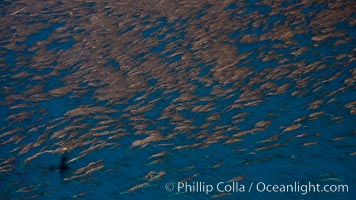
Kelp beds adorn the coastline of San Clemente Island, aerial photograph.
Species: Giant kelp, Macrocystis pyrifera
Location: San Clemente Island, California
Image ID: 25984
Species: Giant kelp, Macrocystis pyrifera
Location: San Clemente Island, California
Image ID: 25984
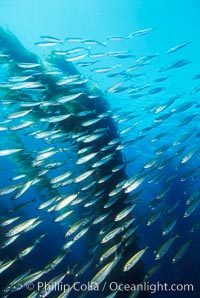
Jack mackerel and kelp.
Species: Pacific jack mackerel, Macrocystis pyrifera, Trachurus symmetricus
Location: San Clemente Island, California
Image ID: 00380
Species: Pacific jack mackerel, Macrocystis pyrifera, Trachurus symmetricus
Location: San Clemente Island, California
Image ID: 00380
